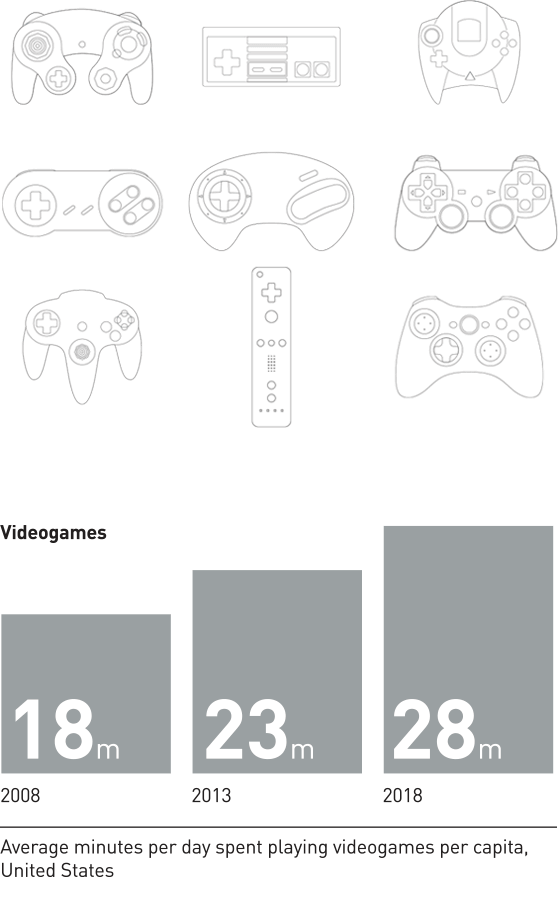The Dallas Cowboys’ AT&T Stadium will sell out, for an entire week (at an average ticket price over $100) as fans pack in to watch on the Diamond Vision — not a football team but teenagers playing the war game League of Legends 5, set in the fantasy land of Azeroth.
-
01
E-sports competitions are big business, with prize pools topping $10 million at a single tournament.
-
02
Massive popularity of watching video games online as entertainment.
DisruptionThe Celebrity Gamer | OpportunityThe best play for league franchises: Get closer to the gamer community. Gamers play as their favorite athletes, and athletes become fans of the best gamers — even to the point of recruiting top players to use their avatars. By embracing the gaming experience, pro sports leagues stand to foster more allegiance to their league, team, and players. | |
DisruptionCompetition for the Most Finite Resource: Time | OpportunityDespite increasing time spent on video games, gamer households are more tuned into sports on TV than ever. In what appears to be a virtuous cycle, traditional sports are actually benefiting from the growing sports game market. The large American turnout for last summer’s World Cup has been partly attributed to popularity driven by the Electronic Arts’ FIFA game franchise. | |
DisruptionFans Want to Control the Action | OpportunityReal-world leagues should accelerate integration with their fantasy sports alter egos. TV viewership among fantasy fans is double that of non-fantasy fans, making it a perfect complement to TV broadcast. The now multibillion dollar industry has grown by 10 million fans since 2010, reaching an estimated audience of 41 million in North America. Companies like FanDuel are lowering the time and money investment for fantasy, making it easier for casual fans to participate and increasing overall engagement with their sport. |
Stats from The International, the annual Dota 2 videogame world championship
-
24 minutesTime elapsed before all tickets for the event at Seattle’s 17,000-seat KeyArena sold out
-
$18 millionTotal prize money for the tournament
-
$6.6 millionAmount split among five members of the winning team, Evil Geniuses
On Amazon’s $970 million acquisition of e-sports streaming network Twitch: “It’s no longer just wanting to see how someone defeated the boss on Level 5. It’s having that social experience and the comrade-ship of fellow gamers.”
James Mcquivey
Author Digital Disruption—Unleashing The Next Wave Of Innovation
The biggest metric we’re seeing is that TV viewership is extremely high among fantasy sports fans. Fantasy sports fans consume more than double the TV than that of non-fantasy sports fans. Ten years ago networks were sneering at fantasy sports; now they’re catering to us.
Paul Charchian
President, Fantasy Sports Trade Association
Last year, Robert Morris University in Illinois offered 45 athletic scholarships to League of Legends video game players. Yes, athletic scholarships for joystick jockeys. It turns out that when gamers stop playing against the computer and instead play against other real people, videogames take on the human drama of sports. E-sports are here to stay.
One challenge for the sports industry: making sure kids keep playing sports titles rather than other genres. One leg up: Sports are a universal language, easy to get grounded in and understand. Drop into a basketball video game for the first time, and you intuitively have a sense of what to do — get the ball in the hoop, or go for a rebound. Drop into League of Legends, and the average rookie would be totally lost. This is sports’ massive initial advantage — which it needs to press forward on immediately while this market emerges.
Game technology is advancing beyond the current realm of recreation into player training, improvement, and comprehensive metric feedback. NASCAR is out to an early lead, using their racing simulator iRace not just to give fans their most realistic chance at driving a stock car, but also to train professionals — including motorsports legend Dale Earnhardt Jr.

Industry leader EA Sports has consistently advanced the in-home stadium experience. Soccer title FIFA 15 bathes gamers in authentic stadium cheers, chants, and reactions — each soundscape unique to one of the 20 Premier League stadiums. Ignite, EA’s new game engine, features player-specific movement that depends on weight, momentum, and center of gravity. Even clothing stretches, billows, and affects a player just as it would in real life.
Predicting the Future
-
1-5 Years
Talent Ecosystem Emerges
-
Fans will find it increasingly easy to “play” against their idols. Not only will individual gamers become famous, but teams leagues, and franchises will also coalesce. EA has invested heavily in FIFA Pro Clubs, which allow for up to 11 players on one team to face off against opponents online. A talent ecosystem will emerge, including coaches, high school and college teams, ranked amateurs, farm clubs, semipro and full-time professional players. As with sports, scouts will evaluate and offer contracts to younger and younger players.
-
5-10 Years
Better Controllers
-
It’s no longer about thumbs hitting controller buttons. Game-play sensors descended from the Wii and Microsoft Kinect make handheld controllers a quaint memory. A language of game control involving every limb and facial expression emerges, physical shorthand for larger movements in the video sport.
-
10-25 Years
Indistinguishable Remote and In-Person Gameplay
-
Remote and in-person gameplay will be all but indistinguishable thanks to the combination of tactile feedback interfaces with virtual and augmented reality. As offline sports and online sports adapt to players’ locations and abilities, participation in sports — a definition that now implicitly includes e-sports — will soar to include a higher percentage of humanity than at any other time.

